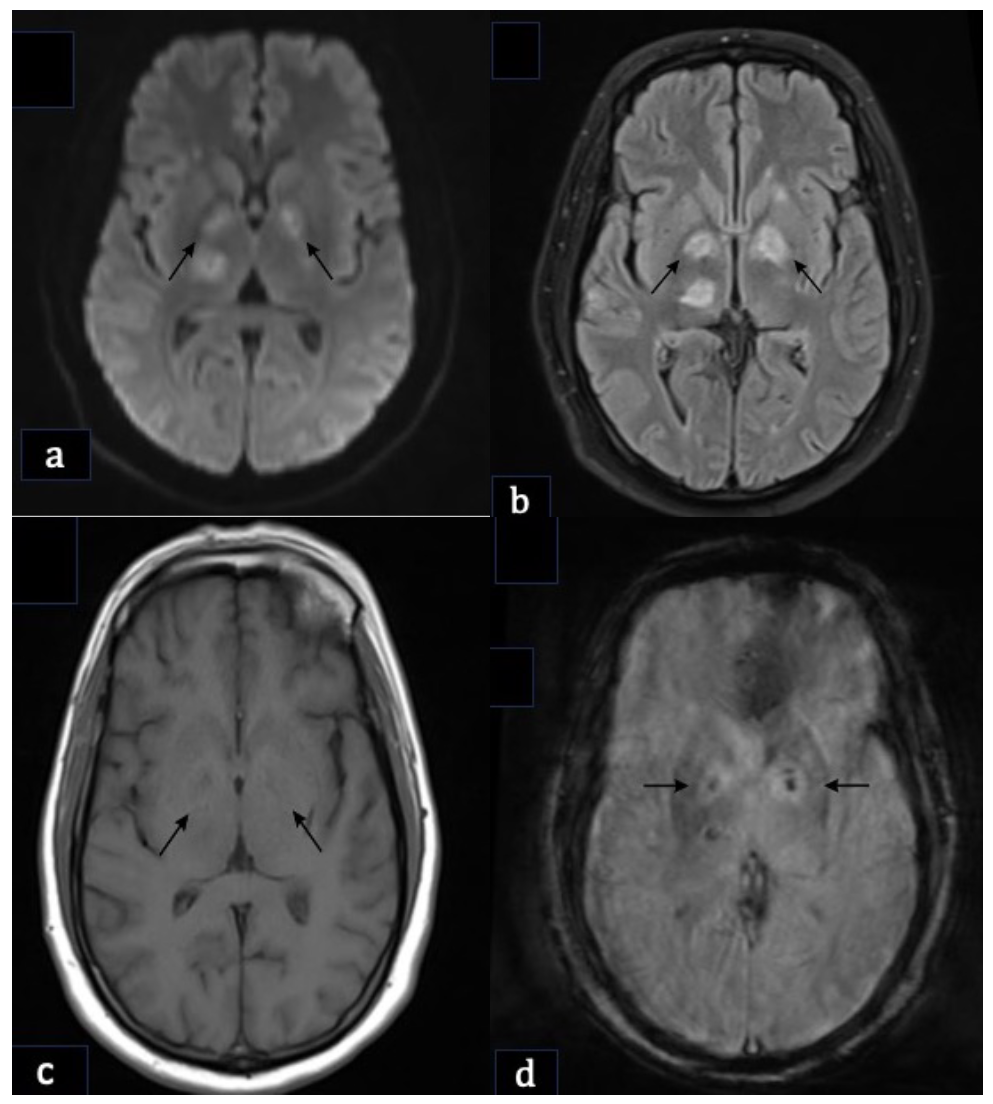Translate this page into:
Radiological findings often lead to clinical diagnosis. A case of disulfiram ethanol reaction with stroke
* Corresponding author: Dr. Bindu Menon, Department of Neurology, Apollo Speciality Hospitals, Nellore, Andhra Pradesh, India. bindu.epilepsycare@gmail.com
-
Received: ,
Accepted: ,
How to cite this article: Menon B, Manam G, Reddy P, Rasmi JC, Varshith TMS. Radiological findings often lead to clinical diagnosis. A case of disulfiram ethanol reaction with stroke. Ann Natl Acad Med Sci (India). doi: 10.25259/ANAMS_1073_2023
A 40-year-old man with a history of alcohol dependence was brought to the emergency department with right lower limb ataxia after a week of heavy drinking. He was found unconscious in a pub. Magnetic resonance imaging axial diffusion [Figure 1a] and flair images [Figure 1b] show symmetric diffusion restriction involving globus pallidi with corresponding flair hyperintensities with right thalamus acute infarct. T 1 weighted image [Figure 1c] was normal. Susceptibility weighted imaging image [Figure 1d] shows punctuate hemorrhages within globus pallidi.

- (a) MRI axial diffusion and (b) flair images show symmetric diffusion restriction involving globus pallidi with corresponding flair hyperintensities with right thalamus acute infarct. (c) T 1 weighted image was normal. (d) SWI image shows punctuate haemorrhages within globus pallidi. SWI: Susceptibility weighted imaging.
Bilateral globus pallidus infarcts are rare, and differentials like carbon monoxide poisoning, COVID-19 hypoxia, methylmalonic acidemia, cocaine, and disulfiram toxicity1 were ruled out in the initial evaluation. With radiological information leading to further questioning of his wife, she admitted to having secretly given him disulfiram for five days to deter his drinking, causing a disulfiram-ethanol reaction and an ischemic stroke. This case underscores the role of thorough history assessment and radiology in uncovering these critical details.
Authors’ contributions
BM: Collected patient data and drafted and revised the manuscript; GM: Revised the data for accuracy; PR: Collected patient data and revised the manuscript; JCR: Revised the manuscript; TMSV: Contributed to data collection and manuscript revision.
Ethical approval
Institutional Review Board approval is not required.
Declaration of patient consent
Patient’s consent not required as patients identity is not disclosed or compromised.
Financial support and sponsorship
Nil.
Conflicts of interest
There are no conflicts of interest.
Use of artificial intelligence (AI)-assisted technology for manuscript preparation
The authors confirm that there was no use of Artificial Intelligence (AI)-Assisted Technology for assisting in the writing or editing of the manuscript and no images were manipulated using AI.
Reference
- Bilateral globus pallidus lesions. BMJ Case Rep.. 2021;14:e241088.
- [CrossRef] [PubMed] [PubMed Central] [Google Scholar]





